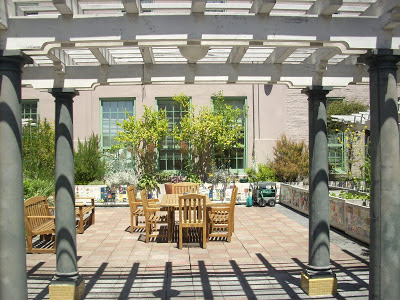May is Older Americans Month
All the lonely people, where do they all belong?
--“Eleanor Rigby” by Lennon-McCartney
At this month’s Coalition of Agencies Serving the Elderly (http://www.sfseniors.org/) meeting, UCSF geriatrician Dr. Carla Perissinotto presented “Examining Loneliness in Older Adults: Too much hype or a true medical concern?” She found that loneliness is independently associated with functional decline, placing one at risk for nursing home admission, and increased rate of death.
Dr. Perissinotto analyzed data in the Health and Retirement Study, which asked 1,604 older adults the following three questions to screen for loneliness:
1. I feel left out
2. I feel isolated
3. I lack companionship
Participants were classified as lonely if they responded “some of the time” or “often” to any of these questions.
Loneliness is the distress that a person subjectively feels about being alone (http://psychology.uchicago.edu/people/faculty/cacioppo/jtcreprints/hc09.pdf). Social isolation (a complete or near-complete lack of contact with society) by itself does not account for loneliness, said Dr. Perissinotto. Thus, one can be lonely without living alone. Her research found that 62.5% of married/partnered participants felt lonely, compared to 26.7% of participants who lived alone felt lonely. She also found the following groups reported more loneliness: women, non-white, slightly older and lower socioeconomic status. Further, most lonely participants are not depressed.
Dr. Perissinotto believes we can make a difference by asking about loneliness (like asking about chronic disease risk factors) and offering interventions from existing community programs to help adults feel more socially connected.
Lemon trees and raised vegetable beds surround outdoor dining area at On Lok (“peaceful, happy abode” in Cantonese) Gee Center
Carp (or koi, homophone for “love” in Japanese) and lotus pond at On Lok Gee Center
Loneliness as public health crisis
In a related article published this month, “The Lethality of Loneliness” (http://www.newrepublic.com/article/113176/science-loneliness-how-isolation-can-kill-you), The New Republic science writer Judith Shulevitz notes that loneliness causes or exacerbates Alzheimer’s, obesity, diabetes, high blood pressure, heart disease, neurodegenerative diseases, and even cancer. Researchers differ on whether loneliness is a subjective feeling that wreaks havoc on the body and brain, or a failure of social networks to take care of the lonely.
Shulevitz reports that the lonely are outsiders: the elderly, the poor, the bullied, the different. People who feel discriminated against are more likely to feel lonely than those who don’t, even when they don’t fall into the categories above, due to feeling rejected. For example, psychologists discovered that closeted gay men who had to be guarded about their true identity for fear of exposure/blackmail, were more sensitive than others to the pain of rejection, increasing a fight-or-flight response system arouses stress hormones that compromise their immune system—such that closeted men infected with HIV died an average of two to three years earlier than out men.
Similarly, a common “alone-on-the-savanna moment” that could put the body in fight-or-flight mode is going off to college and having to make a whole new set of friends. When I left home as a teenager to attend a women’s college over 2,000 miles away, I had to adapt to the intense, competitive and consciousness-raising experience of living on-campus with the typical age 17-22 group. Since I had been privileged to grow up in a multi-generational household, I really missed the safety and mellowing “been there, done that” wisdom of older adults.
Please Touch Community Garden
Letters spelling out "TO SEE A WORLD YOU OTHERWISE COULD NOT SEE" lean against wall behind raised vegetable beds. May is Healthy Vision Month (http://www.nei.nih.gov/hvm/): For healthy vision, National Eye Institute recommends eating a diet rich in green, leafy vegetables like the ones grown at Please Touch Community Garden.
Quality over quantity of relationships
Another “alone-on-the-savanna moment” could be moving to an age-segregated retirement resort in Florida
I planted these mugworts (Artemisia vulgaris) from The Free Farm last year. Mugwort's bitter leaves can be made into a tea for use as a digestive tonic. In Traditional Chinese Medicine, acupuncturists burn mugwort in moxibustion.
How can we address loneliness and the stigma of being “different” to allow people to be authentic instead of “passing” as someone else out of fear of rejection? How can people connect better to develop strong bonding that reinforces ties between similar groups, as well as bridging social capital among diverse groups? A cultural humility approach coupled with an introvert’s power to listen and ask follow-up questions can help with understanding to find common ground and mutual acceptance.
According to Dr. Melanie Tervalon, cultural humility involves practicing lifelong learning and critical self-reflection (awareness of potential bias), recognizing and challenging power imbalances (using person-focused interviewing and meeting people where they are to facilitate mutual respect), and accountability (readjust if necessary to remain open-minded) (http://info.kaiserpermanente.org/communitybenefit/assets/pdf/our_work/global/Cultural_Humility_article.pdf).
Cultural humility respects “voice by choice,” or giving people the space and time to speak up voluntarily—and not putting people on the spot and assuming they should respond the way one expects because one is already culturally competent. People are complex, however much one may want to simplify by classifying individuals into “cultural” groups or stereotyping. Only when people’s true voices are heard first, then we can begin the process of understanding and empowering people with self-determination to choose how we age or live our lives. When we are free to be you and me, building community together, we unleash the power of age!
This bright pink seed-planting table is accessible to persons using wheelchairs
GK created this totem pole using ceramic animal figures from Santa Clara Valley Blind Center







